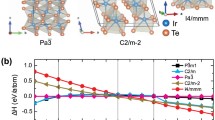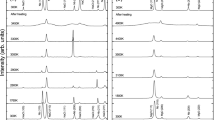Abstract
We report here high-pressure x-ray diffraction (XRD) studies on tellurium (Te) at room temperature up to 40 GPa in the diamond anvil cell (DAC). The XRD measurements clearly indicate a sequence of pressure-induced phase transitions with increasing pressure. The data obtained in the pressure range 1 bar to 40 GPa fit five different crystalline phases out of Te: hexagonal Te (I) → monoclinic Te(II) → orthorhombic Te (III) → Β-Po-type Te(IV) → body-centered-cubic Te(V) at 4, 6.2, 11 and 27 GPa, respectively. The volume changes across these transitions are 10%, 1.5%, 0.3% and 0.5%, respectively.
Self consistent electronic band structure calculations both for ambient and high pressure phases have been carried out using the tight binding linear muffin tin orbital (TB-LMTO) method within the atomic-sphere approximation (ASA). Reported here apart from the energy band calculations are the density of states (DOS), Fermi energy (E f) at various high-pressure phases. Our calculations show that the ambient pressure hexagonal phase has a band gap of 0.42 eV whereas high-pressure phases are found to be metallic. We also found that the pressure induced semiconducting to metallic transition occurs at about 4 GPa which corresponds to the hexagonal phase to monoclinic phase transition. Equation of state and bulk modulus of different high-pressure phases have also been discussed.
Similar content being viewed by others
References
Raiph W G Wyckoff,Crystal Structures, (Interscience Publishers, New York, 1963) Second Edition, Volume 1, pp.36
W B Holzapfel,Rep. Prog. Phys. 59, 29 (1996) and also
G Parthasarthy and W B Holzapfel,Phys. Rev. B37, 6499 (1988)
T Kruger and W B Holzapfel,Phys. Rev. Lett. 69, 305 (1992)
Y Akahama, M Kobayashi and H Kawamura,Phys. Rev. B46, 6662 (1993)
Y Ohmasa, I Yamamoto, M Yao and H Endo,J. Phys. Soc. Japan,64, 4766 (1995) and the references therein.
Y Akahama, M Kobayashi and H Kawamura,Phys. Rev. B47, 20 (1993)
Y Shimoi and H Fukutome,Prog. Theor. Phys. 87, 307 (1992)
G Doerre and J D Joannopoulos,Phys Rev. Lett. 43, 1040 (1979)
F Kirchhoff, N Binggeli and G Galli,Phys. Rev. B50, 9063 (1994)
R M Martin, G Lucovsky and K Helliwell,Phys. Rev. B13, 1363 (1976)
O K Anderson,Phys. Rev. B12, 3060 (1975)
H L Skriver,The LMTO method (Springer-Verlag), 1984
OK Anderson and O Jepsen,Phys. Rev. Lett. 53, 2571 (1984)
G K Kalpana, B Palanivel and M RajagopalanPhys. Rev. B50, 12316 (1994) and references therein (I B Shameem Banu, B Palanivel, G Kalpana, P Shenbagaraman and M Rajagopalan,Advances in high pressure science and technology, edited by M Yousuf, N Subramanian, K Govinda Rajan (University Press, Orient-Longman Limited, Hyderabad, 1997) page 302
A K Bandyopadhyay and L C Ming,Phys. Rev. B54, 12049 (1996)
P Ch Sahu, Mohammad Yousuf, N V Chandra Shekar, N Subramanian and K Govindarajan,Rev. Sei. Instrum. 66, 295 (1995)
K Aoki, O Shimomura, S Minomura, N Koshizuka and T Tsushgwa,J. Phys. Soc. Japan 48, 906 (1980)
W Kohn and L J Sham,Phys. Rev. 140, 1133 (1965)
U von Barth and L Hedin,J. Phys. C5, 1629 (1972)
N E Christensen,Phys. Rev. B32, 207 (1985)
G Kalpana, B Palanivel and M Rajagopalan,Phys. Rev. B50, 12318 (1994)
D B Singh, A K Bandyopadhyay, M Rajagopalan, P Ch Sahu, M Yousuf and K Govindarajan,Solid State Commun. 109, 339 (1999)
O Jepsen and O K Andersen,Solid State Commun. 9, 1763 (1971)
M Rajagopalan,Advances in high pressure science and technology, edited by M Yousuf, N Subramanian, K Govinda Rajan (University Press, Orient-Longman Limited, Hyderabad, 1997) 264 and 330
R Keller, W B Holzapfel and H Schulz,Phys. Rev. B16, 4404 (1977)
K Aoki, O Shimomura and S Minomura,J. Phys. Soc. Japan 48, 551 (1980)
R Jeanloz,Geophys. Res. Lett. 6, 1219 (1961)
D Xiong, L C Ming and M H Manghnani,Phys. Earth Planet. Int. 43, 244 (1967)
Author information
Authors and Affiliations
Rights and permissions
About this article
Cite this article
Bandyopadhyay, A.K., Singh, D.B. Pressure induced phase transformations and band structure of different high pressure phases in tellurium. Pramana - J Phys 52, 303–319 (1999). https://doi.org/10.1007/BF02828893
Received:
Revised:
Issue Date:
DOI: https://doi.org/10.1007/BF02828893




